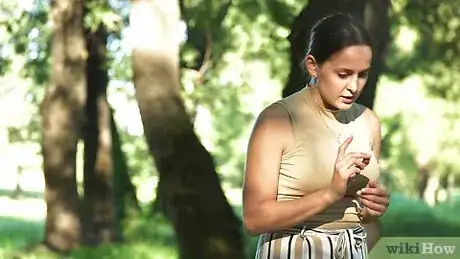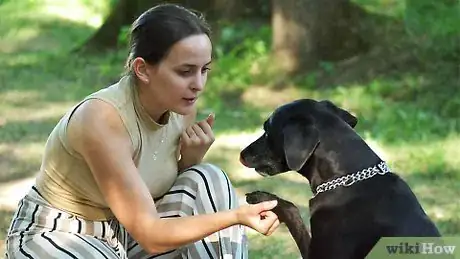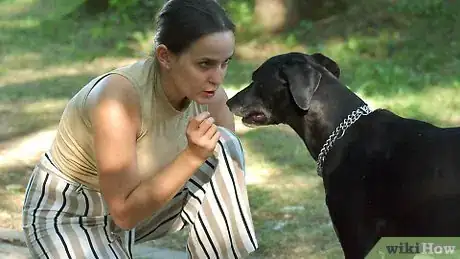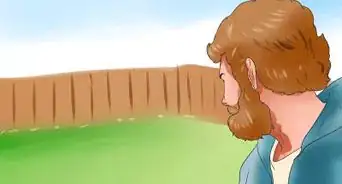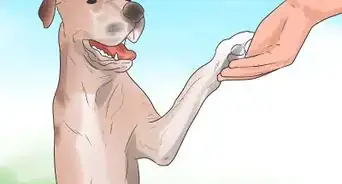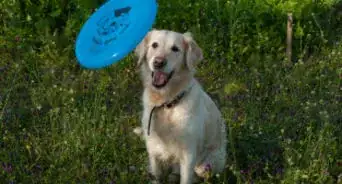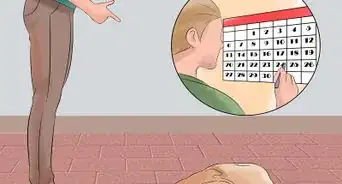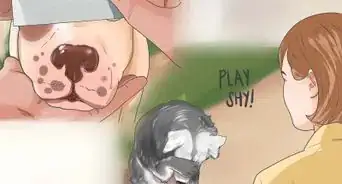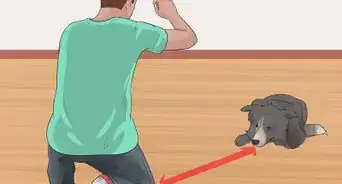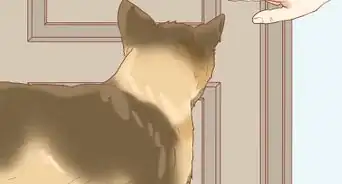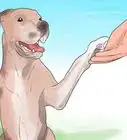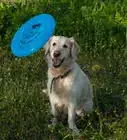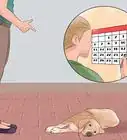This article was co-authored by Beverly Ulbrich. Beverly Ulbrich is a Dog Behaviorist and Trainer and the Founder of The Pooch Coach, a private dog training business based in the San Francisco Bay Area. She is a Certified CGC (Canine Good Citizen) Evaluator by the American Kennel Club and has served on the Board of Directors for the American Humane Association and Rocket Dog Rescue. She has been voted the best private dog trainer in the San Francisco Bay Area 4 times by SF Chronicle and by Bay Woof, and she has won 4 "Top Dog Blog" awards. She has also been featured on TV as a dog behavior expert. Beverly has over 18 years of dog behavior training experience and specializes in dog aggression and anxiety training. She has a Master of Business Administration from Santa Clara University and a BS from Rutgers University.
wikiHow marks an article as reader-approved once it receives enough positive feedback. In this case, 100% of readers who voted found the article helpful, earning it our reader-approved status.
This article has been viewed 282,529 times.
The trick of a dog offering you its paw is a simple yet very entertaining one. It won't take long for you to train your dog to give you his paw, but it should only be taught in short bursts, over a few days. Eventually your dog will be able to give you its paw and then even shake paw-to-hand with you.
Steps
Preparing to Train Your Dog
-
1Select a treat. Treats are an important part of the training process. They serve as tasty rewards when your dog performs a desired action, no matter how small. In general, treats for training should be especially scrumptious to your dog, and should be reserved for training purposes.
- Choose treats that are not crumbly. Your dog may take more interest in sniffing out and eating the crumbs rather than paying attention to what you are trying to teach him.
- Examples of treats include bits of cheese or hot dog and small liver cookies.
- While you are teaching your dog to give you his paw, rewarding your dog with treats should always be paired with verbal praise.[1]
-
2Choose a verbal command. Verbal commands are another helpful component of the training process.[2] Common verbal commands for this trick include ‘paw’, 'shake', and ‘give your paw.’[3] Whichever command you choose, use it consistently throughout the training process to avoid confusing your dog.
- If you have multiple members of your household, make sure that each person uses the same verbal command for this trick.
- Short, concise commands are preferable—your dog will understand and respond to these better than long phrases or sentences (e.g., ‘It’s time to give me your paw’).
Advertisement -
3Pick a training area. Even though teaching your dog to give you his paw is relatively easy, your training sessions will go much more smoothly if he is not distracted. Inside your home, create a ‘distraction free’ zone—turn off the television, keep other pets and people outside of the area, and remove any distracting toys. The fewer the distractions, the better.[4]
- If you have an enclosed yard, you can train him outside with relatively few distractions.
Teaching Your Dog to Give You His Paw
-
1Command your dog to sit. Teaching your dog to give you his paw will be easier if your dog is already in the sitting position. If your dog does not already know how to sit, you can teach him by holding a treat in front of his nose, far enough away so that he cannot reach for it. Next, slowly raise your hand high over your dog’s head. As your dog raises his head to follow the treat, push down gently on his backside to get him to sit.[5]
- Give him a verbal command (‘sit’ or ‘down’) as you press down on his backside. Immediately praise him and give him the treat when his bottom touches the floor.[6]
- Do not give him the treat if he stands back up and reaches for it. Firmly say ‘no’ if he does this.[7]
- Practice this several times a day for 10 to 15 minutes at a time. Eventually, your dog will learn to sit and remain seated to receive the treat.[8]
-
2Hold a treat in front of your dog’s nose. Unlike with training your dog to sit, your dog should not see the treat during the entire training process. Rather, you will show your dog the treat to get his attention, and then create a fist to hide the treat.[9]
-
3Wait for your dog to stretch out his paw to you. This may not take long if your dog regularly uses his paws to get your attention or play. If this is not how your dog uses his paws, though, he may first try to grab the treat with his mouth instead. Do not respond if he uses his mouth—this is not the desired behavior.[10]
- When he lifts his paw, even if it is just slightly off the ground, immediately give him verbal praise (‘good boy,’ ‘yes’) and open your fist to give him the treat.[11] [12]
- You can still reward him if he simply shifts his weight to lift his paw—this is still an effort in the right direction.[13]
- If you are using a clicker, then you would click as soon your dog lifts his paw (or shifts his weight to lift his paw).[14]
- Use your other hand to grab his paw when he lifts it.[15] This will be easier if you are not using a clicker.
- Do not reprimand your dog if he uses his mouth. Rewarding only the desired behavior (lifting his paw) and ignoring the undesired behavior (using his mouth) will teach your dog to the repeat the desired behavior.
- If your dog doesn't stretch out its paw, try picking up or tapping on their paw to encourage it.[16]
-
4Use a verbal cue.[17] Once your dog consistently lifts his paw in response to the ‘fisted’ treat, add in a verbal cue to the trick.[18] Use whichever verbal cue you chose prior to beginning your training sessions. Say the cue after you have closed your fist, and before he lifts his paw to get the treat.
- Immediately praise and reward your dog when he lifts his paw in response to your verbal cue.
- The goal is to teach your dog to give you his paw in response to only your verbal cue, without you holding a treat in front of his nose. Gradually phase out the treats over several training sessions.[19]
- Do not repeat the verbal cue to get your dog to follow your command.[20] If your dog does not respond the first time, it could be that he does not yet understand the command. If this is the case, continue to practice the cue over multiple training sessions.
-
5Challenge your dog. As your dog gets more skilled with this trick, add in some challenges. For example, practice the trick in different situations and locations where there will be distractions (e.g., cars, people, other dogs).[21]
- You can also teach your dog to lift both paws. If you would like to do this, use a different verbal cue for the other paw to avoid confusing your dog as to which paw he should lift.[22]
Expert Q&A
Did you know you can get expert answers for this article?
Unlock expert answers by supporting wikiHow
-
QuestionHow do you get a dog to give you their paw?
 Melissa Nelson, DVM, PhDDr. Nelson is a Veterinarian who specializes in Companion and Large Animal Medicine in Minnesota, where she has over 18 years of experience as a veterinarian in a rural clinic. She received her Doctor of Veterinary Medicine from the University of Minnesota in 1998.
Melissa Nelson, DVM, PhDDr. Nelson is a Veterinarian who specializes in Companion and Large Animal Medicine in Minnesota, where she has over 18 years of experience as a veterinarian in a rural clinic. She received her Doctor of Veterinary Medicine from the University of Minnesota in 1998.
Veterinarian
-
QuestionHow do you teach a dog to give?
 Melissa Nelson, DVM, PhDDr. Nelson is a Veterinarian who specializes in Companion and Large Animal Medicine in Minnesota, where she has over 18 years of experience as a veterinarian in a rural clinic. She received her Doctor of Veterinary Medicine from the University of Minnesota in 1998.
Melissa Nelson, DVM, PhDDr. Nelson is a Veterinarian who specializes in Companion and Large Animal Medicine in Minnesota, where she has over 18 years of experience as a veterinarian in a rural clinic. She received her Doctor of Veterinary Medicine from the University of Minnesota in 1998.
Veterinarian
-
QuestionHow do you teach a dog to give?
 Pippa Elliott, MRCVSDr. Elliott, BVMS, MRCVS is a veterinarian with over 30 years of experience in veterinary surgery and companion animal practice. She graduated from the University of Glasgow in 1987 with a degree in veterinary medicine and surgery. She has worked at the same animal clinic in her hometown for over 20 years.
Pippa Elliott, MRCVSDr. Elliott, BVMS, MRCVS is a veterinarian with over 30 years of experience in veterinary surgery and companion animal practice. She graduated from the University of Glasgow in 1987 with a degree in veterinary medicine and surgery. She has worked at the same animal clinic in her hometown for over 20 years.
Veterinarian To teach "give," make this a fun game of swapsies. Start with two identical toys. Play with one to make it interesting and then let the dog have it. Let the dog hold it for a short time, then show them the other (identical toy). Most dogs then drop the one they're holding, at which point, say "Give," and allow them to have the duplicate. Keep repeating this.
To teach "give," make this a fun game of swapsies. Start with two identical toys. Play with one to make it interesting and then let the dog have it. Let the dog hold it for a short time, then show them the other (identical toy). Most dogs then drop the one they're holding, at which point, say "Give," and allow them to have the duplicate. Keep repeating this.
References
- ↑ Beverly Ulbrich. Dog Behaviorist & Trainer. Expert Interview. 30 January 2020.
- ↑ Beverly Ulbrich. Dog Behaviorist & Trainer. Expert Interview. 30 January 2020.
- ↑ http://www.animalbehaviorcollege.com/tips_by_category.asp?TipCategoryID=7
- ↑ http://www.animalbehaviorcollege.com/tips_by_category.asp?TipCategoryID=7
- ↑ http://www.dogbreedinfo.com/training.htm
- ↑ http://www.dogbreedinfo.com/training.htm
- ↑ http://www.dogbreedinfo.com/training.htm
- ↑ http://www.dogbreedinfo.com/training.htm
- ↑ https://www.vetbabble.com/dogs/training-and-behavior/teach-dog-shake/
- ↑ http://www.dogs-day.com/tricks-and-fun/teach-give-paw-or-shake-hands
- ↑ http://www.animalbehaviorcollege.com/tips_by_category.asp?TipCategoryID=7
- ↑ https://www.vetbabble.com/dogs/training-and-behavior/teach-dog-shake/
- ↑ https://www.vetbabble.com/dogs/training-and-behavior/teach-dog-shake/
- ↑ http://www.animalbehaviorcollege.com/tips_by_category.asp?TipCategoryID=7
- ↑ https://www.vetbabble.com/dogs/training-and-behavior/teach-dog-shake/
- ↑ Beverly Ulbrich. Dog Behaviorist & Trainer. Expert Interview. 30 January 2020.
- ↑ Beverly Ulbrich. Dog Behaviorist & Trainer. Expert Interview. 30 January 2020.
- ↑ http://www.dogs-day.com/tricks-and-fun/teach-give-paw-or-shake-hands
- ↑ http://www.dogs-day.com/tricks-and-fun/teach-give-paw-or-shake-hands
- ↑ http://www.animalbehaviorcollege.com/tips_by_category.asp?TipCategoryID=7
- ↑ http://www.animalbehaviorcollege.com/tips_by_category.asp?TipCategoryID=7
- ↑ http://www.dogs-day.com/tricks-and-fun/teach-give-paw-or-shake-hands
- ↑ http://www.dogs-day.com/tricks-and-fun/teach-give-paw-or-shake-hands
- ↑ https://www.vetbabble.com/dogs/training-and-behavior/teach-dog-shake/
- ↑ https://www.vetbabble.com/dogs/training-and-behavior/teach-dog-shake/
About This Article
To train a dog to give you its paw, start by commanding your dog to sit. While seated, hold a treat in front of your dog’s nose. Now, wait for your dog to stretch out its paw to you. Although your dog will raise its paw to get your attention for the treat, immediately give your dog verbal praise as well as the treat. When your dog begins to consistently raise its paw in response to a treat, you can add a verbal command, such as "paw," to cue your dog. For more tips from our Veterinary reviewer, including how to pick a training area, keep reading!


